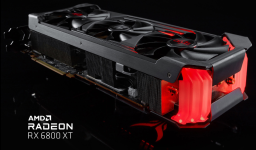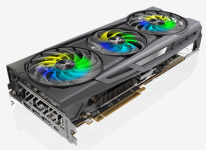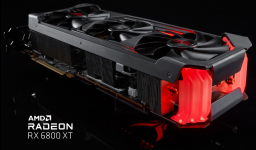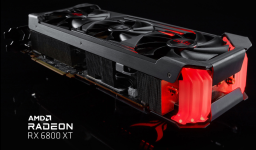-
Competitor rules
Please remember that any mention of competitors, hinting at competitors or offering to provide details of competitors will result in an account suspension. The full rules can be found under the 'Terms and Rules' link in the bottom right corner of your screen. Just don't mention competitors in any way, shape or form and you'll be OK.
You are using an out of date browser. It may not display this or other websites correctly.
You should upgrade or use an alternative browser.
You should upgrade or use an alternative browser.
The thread which sometimes talks about RDNA2
- Thread starter CAT-THE-FIFTH
- Start date
- Status
- Not open for further replies.
More options
Thread starter's postsCaporegime
Come on you being giving Humbug some stick, all fair in love and war.

Soldato
On the Sapphire website it says 850W for the Nitro+.
So let's see: RDNA2 can`t do RT.
Yet we have Miles Morales and WD Legion, both running on RDNA2. Dumbed down versions of the 6800. And they look and run great.
I wouldn't be too concerned about RT on RDNA2. Once some games get optimized and new titles are created, we will see good RT performance on the Big Navi. The problem is AMD are lazy and it will take some time to bring good RT performance to PC video cards. Probably by the time the Big Navi becomes a good RT card, we will have the next generation from Nvidia.
Yet we have Miles Morales and WD Legion, both running on RDNA2. Dumbed down versions of the 6800. And they look and run great.
I wouldn't be too concerned about RT on RDNA2. Once some games get optimized and new titles are created, we will see good RT performance on the Big Navi. The problem is AMD are lazy and it will take some time to bring good RT performance to PC video cards. Probably by the time the Big Navi becomes a good RT card, we will have the next generation from Nvidia.

Soldato
On the Sapphire website it says 850W for the Nitro+.
My Sapphire Pulse Vega said on the box 750w PSU...
Soldato
My Sapphire Pulse Vega said on the box 750w PSU...
and what do you run it with?
So let's see: RDNA2 can`t do RT.
Yet we have Miles Morales and WD Legion, both running on RDNA2. Dumbed down versions of the 6800. And they look and run great.
30fps isn't running great and while they have RT it's very dumbed down versions of it. The point of ray tracing is to create realistic simulations but when you dumb it down like consoles are doing, all you're simulating is a vaseline filter.
They look much better than they should since they only have a half of Big Navi inside and you think that Big Navi cat't do RT at a decent FPS. It is normal to have the RT dumbed down because you pay for the whole console less than you pay for the 3070. And that is a dumbed down card already that can`t do RT over 30fps.
I think that what we see now on PC on older titles is some kind of brute force RT from the Big Navi, like the Ryzen is doing in the Intel optimized programs. And that once some games are optimized, the performance will surprise a lot of people. Including Nvidia fanboys but they will not admit they were wrong.
Unfortunately those Intel optimized programs were never optimized for Ryzen so we should not expect to see RT optimization on Big Navi too soon.
I think that what we see now on PC on older titles is some kind of brute force RT from the Big Navi, like the Ryzen is doing in the Intel optimized programs. And that once some games are optimized, the performance will surprise a lot of people. Including Nvidia fanboys but they will not admit they were wrong.
Unfortunately those Intel optimized programs were never optimized for Ryzen so we should not expect to see RT optimization on Big Navi too soon.

Soldato
Soldato
and what do you run it with?
Full system draw (tweaked) less than 325w.
The easiest way to get better numbers is a larger cooler.
It doesn't have to be ugly but they threw that in for free.
Soldato
The easiest way to get better numbers is a larger cooler.
It doesn't have to be ugly but they threw that in for free.
I quite like the looks actually. a lot of AIB cards I find childish (like those with tyre tracks on the back, or the word 'gaming' blazoned all over it as if you need to be reminded that's what its for). This one I don't think is childish, despite being quite OTT.
Soldato
I quite like the looks actually. a lot of AIB cards I find childish (like those with tyre tracks on the back, or the word 'gaming' blazoned all over it as if you need to be reminded that's what its for). This one I don't think is childish, despite being quite OTT.
Stop being so childish dan!

Deleted member 66701
D
Deleted member 66701
error correction sucks, you won't even realize 6 months later that your OC is degrading. AMD has historically had higher RMA rates than Nvidia, so I'm not surprised AMD would ask for error correction to reduce the number of RMA's coming in
You don't half post some ****. Any evidence of higher RMA rates for AMD cards?
Any evidence of higher RMA rates for AMD cards?
Lots of it actually from Mind factory (which is a massive source)
AMD RMA at 3.1% vs 2.2% for Nvidia:
https://techreport.com/news/3472666/amd-gpus-rma-more-than-nvidia-report/
https://www.tomshardware.com/news/a...igures, Nvidia has,50 percent higher RMA rate.
https://www.extremetech.com/gaming/...s-fascinating-pattern-between-amd-nvidia-gpus
You don't half post some ****. Any evidence of higher RMA rates for AMD cards?
Lots of it actually...
He has no idea what he is talking about, error correction simply means it will take more time to render a frame once you increase the GDDR6 frequency over 2100Mhz.
I need this card. Its perfect for my case/room design
Lots of it actually from Mind factory (which is a massive source)
AMD RMA at 3.1% vs 2.2% for Nvidia:
https://techreport.com/news/3472666/amd-gpus-rma-more-than-nvidia-report/
https://www.tomshardware.com/news/amd-nvidia-gpu-rma-rate-listed#:~:text=From these figures, Nvidia has,50 percent higher RMA rate.
https://www.extremetech.com/gaming/...s-fascinating-pattern-between-amd-nvidia-gpus
That's surprisingly low. If I own 100 GPUs I'll only get 2 issues with Nvidia or 3 with AMD. Some people must be really unlucky when you hear about them having issues every other card they buy! Reinforces my suspicion that a lot of reported problems are more likely user error.
Lots of it actually from Mind factory (which is a massive source)
AMD RMA at 3.1% vs 2.2% for Nvidia:
https://techreport.com/news/3472666/amd-gpus-rma-more-than-nvidia-report/
https://www.tomshardware.com/news/amd-nvidia-gpu-rma-rate-listed#:~:text=From these figures, Nvidia has,50 percent higher RMA rate.
https://www.extremetech.com/gaming/...s-fascinating-pattern-between-amd-nvidia-gpus
Bundled averages are marketing **** to sell a story.
Lets look at a more intelligent take. From me.
Firstly remember that this is a time slice that ExtremeTech suggests:
I suspect ... the data only covers the previous 12 months.
Here's the spreadsheet: https://docs.google.com/spreadsheet...sAk2kwKie-DaKplFyco7vwlw3ansFpjNstrpG/pubhtml
Firstly the RMA is fairly low at everyones low end. Shouldn't be too surprising since that's the least innovation and risk.
So the RMA is higher at the top end yes?
See if you can spot (heh) the difference:

It says that Nvidia had considerably worse RMA numbers with their high end 2000 series cards than AMD did with their 5700/XT cards.
But that's not what the bundled average number says

Why not?
Because these numbers also include Nvidias 2000 series SUPER cards with substantially lower RMA rates that in turn reduces the overall for Nvidia.
Lets make some better assumptions based on this time slice.
- New high end cards have the worst RMA rates
- New Nvidia cards have a worse RMA rate than new AMD cards
- A refresh of the same series lowers RMA rates
Chuck the bundled averages back in the bin for the clickbaiters.
Maybe people should wait for the refreshed cards of the 3000 series

Last edited:
Caporegime
Bundled averages are marketing **** to sell a story.
Lets look at a more intelligent take. From me.
Firstly remember that this is a time slice that ExtremeTech suggests:
Here's the spreadsheet: https://docs.google.com/spreadsheet...sAk2kwKie-DaKplFyco7vwlw3ansFpjNstrpG/pubhtml
Firstly the RMA is fairly low at everyones low end. Shouldn't be too surprising since that's the least innovation and risk.
So the RMA is higher at the top end yes?
See if you can spot (heh) the difference:

It says that Nvidia had considerably worse RMA numbers with their high end 2000 series cards than AMD did with their 5700/XT cards.
But that's not what the bundled average number says
Why not?
Because these numbers also include Nvidias 2000 series SUPER cards with substantially lower RMA rates that in turn reduces the overall for Nvidia.
Lets make some better assumptions based on this time slice.
- New high end cards have the worst RMA rates
- New Nvidia cards have a worse RMA rate than new AMD cards
- A refresh of the same series lowers RMA rates
Chuck the bundled averages back in the bin for the clickbaiters.
Maybe people should wait for the refreshed cards of the 3000 series
Don't the newest Nvidia cards have the lowest RMA (20 Supers) they're the only cards that have been out same length of time as AMD's 5XXX?
Longer a card has been out, the higher chance of failure. So if we're going to make a comparison, it has to be supers versus 5XXX surely?
EDIT : If those are all GPU's that have sold and failed with 12 months then it's legit comparison, but objectively I'd concede and say Nvidia have improved their GPU quality, so it's not exactly a "Ha got ya Nvidia" moment.
Last edited:
- Status
- Not open for further replies.





